ECU CADILLAC DEVILLE 1998 7.G Owners Manual
[x] Cancel search | Manufacturer: CADILLAC, Model Year: 1998, Model line: DEVILLE, Model: CADILLAC DEVILLE 1998 7.GPages: 386, PDF Size: 22.36 MB
Page 8 of 386
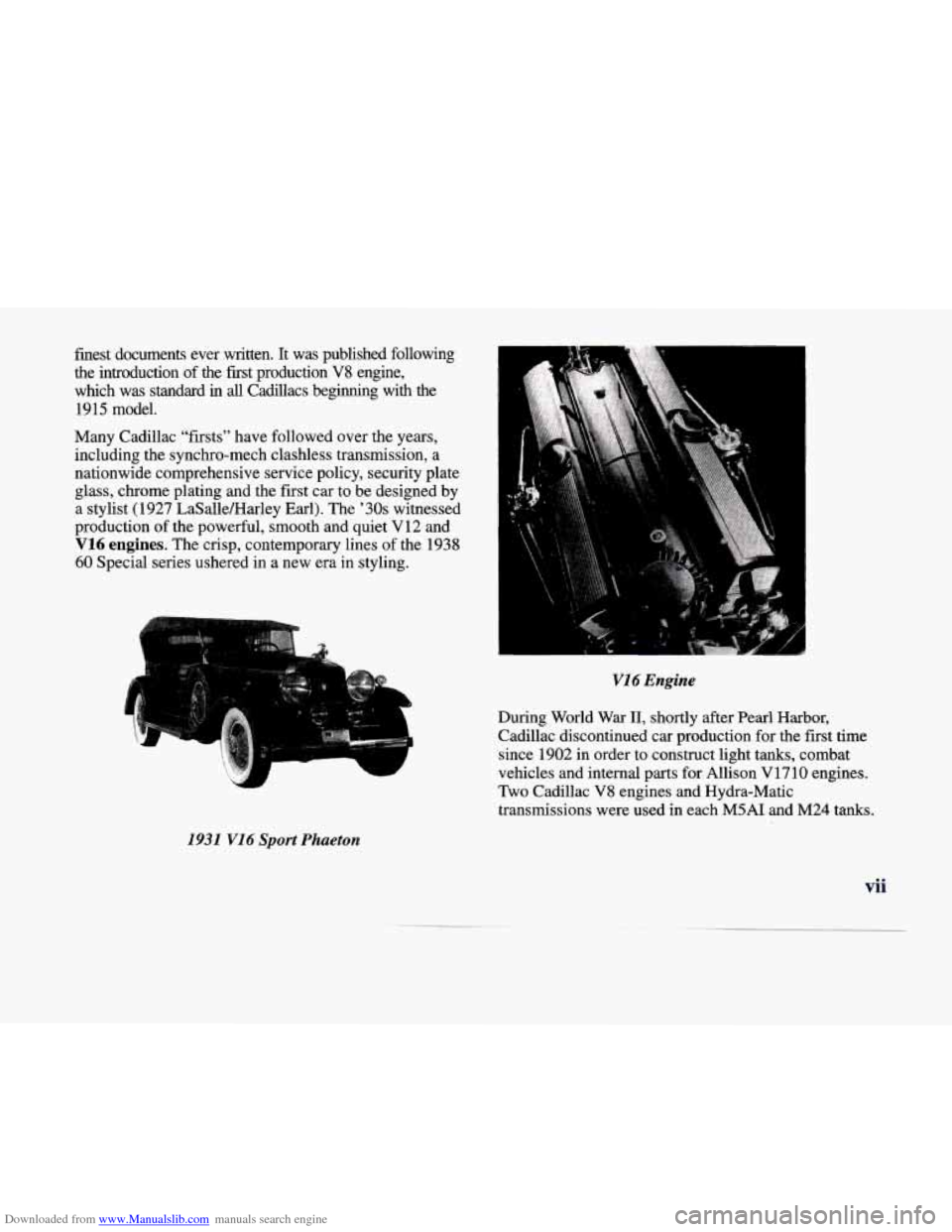
Downloaded from www.Manualslib.com manuals search engine fmest documents ever written. It was published following the introduction of the first production
VS engine,
which was standard in
all Cadillacs beginning with the
1915 model.
Many Cadillac "firsts" have followed over the years, including the synchro-mech clashless transmission, a
nationwide comprehensive service policy, security plate glass, chrome plating and the first car to be designed by
a stylist (1927 LaSallelHarley Earl). The
'30s witnessed
production of the powerful, smooth and quiet V12 and
V16 engines. The crisp, contemporary lines of the 1938
60 Special series ushered in a new era in styling.
VI 6 Engine
During World War 11, shortly after Pearl Harbor,
Cadillac discontinued car production for the first time
since 1902 in order to construct light tanks, combat
vehicles and internal
parts for Allison V17 10 engines.
Two Cadillac
V8 engines and Hydra-Matic
transmissions were used in each MSAI and M24 tanks.
1931 VI 6 Sport Phaeton
vii
Page 27 of 386
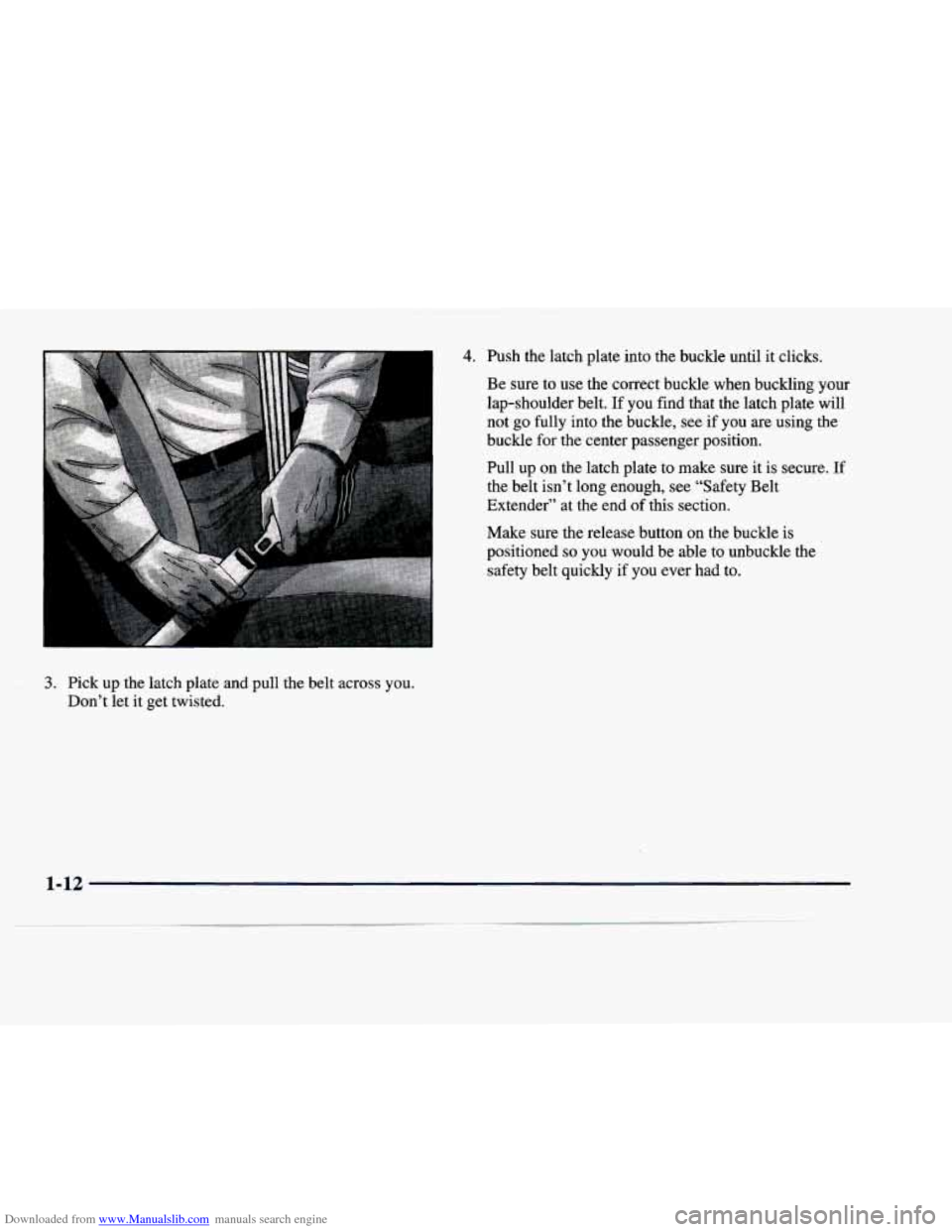
Downloaded from www.Manualslib.com manuals search engine 3. Pick up the latch plate and pull the belt across you.
Don’t let it get twisted.
4. Push the latch plate into the buckle until it clicks.
Be sure to use the correct buckle when buckling your
lap-shoulder belt. If you find that the latch plate will
not go fully into the buckle, see
if you are using the
buckle for the center passenger position.
Pull up on the latch plate to make sure it is secure.
If
the belt isn’t long enough, see “Safety Belt
Extender” at the end of this section.
Make sure the release button on the buckle is
positioned
so you would be able to unbuckle the
safety belt quickly if you ever had to.
1-12
Page 38 of 386
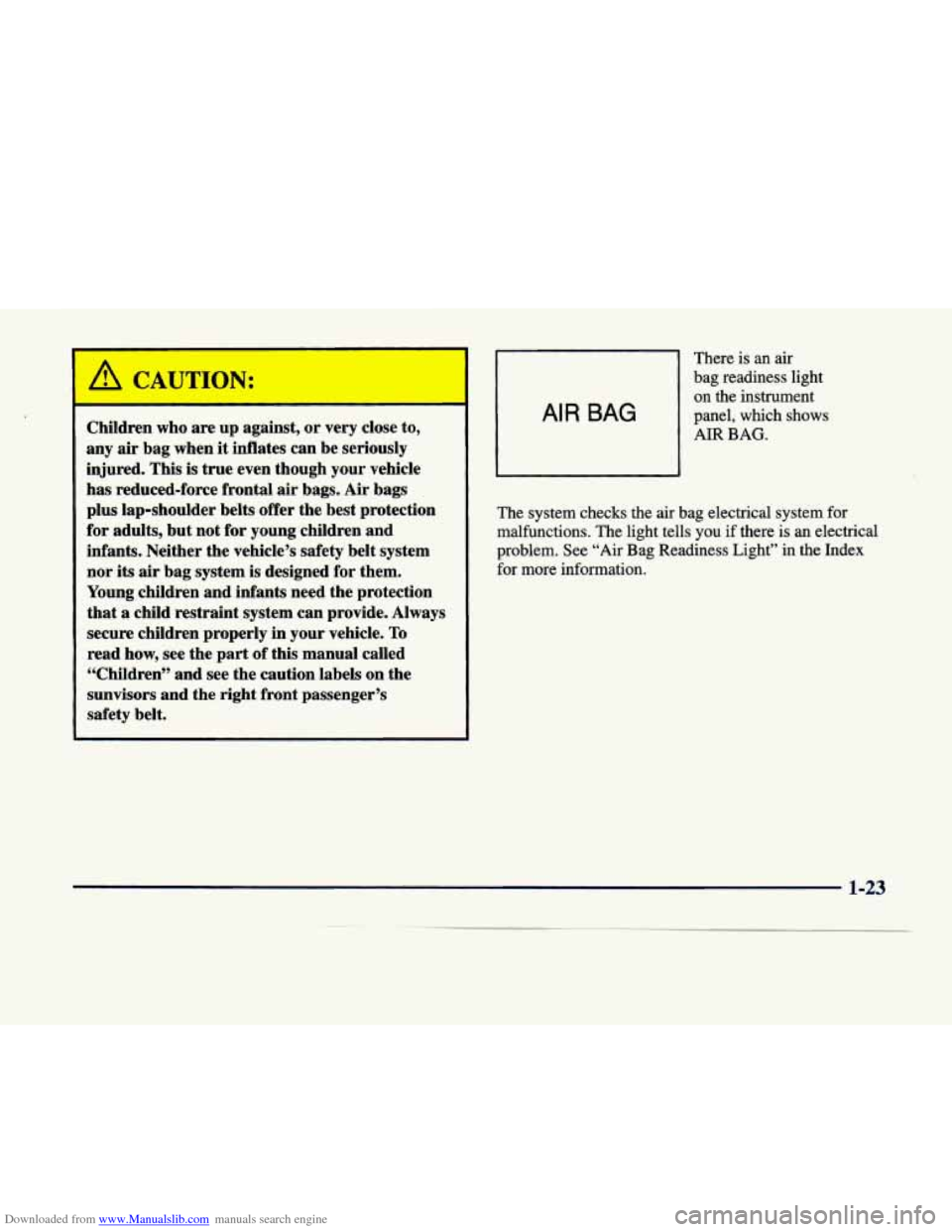
Downloaded from www.Manualslib.com manuals search engine /A CAUTldN:
Children who are up against, or very close to,
any
air bag when it inflates can be seriously
injured. This is true even though your vehicle
has reduced-force frontal air bags. Air bags
plus lap-shoulder belts offer the best protection
for adults, but not for young children and
infants. Neither the vehicle’s safety belt system
nor
its air bag system is designed for them.
Young children and infants need the protection
that
a child restraint system can provide. Always
secure children properly in your vehicle.
To
read how, see the part of this manual called
“Children” and see the caution labels on the
sunvisors and
the right front passenger’s
safety belt.
AIR BAG
There is an air
bag readiness light
on the instrument
panel, which shows
AIR
BAG.
The system checks the air bag electrical system for
malfunctions. The light tells you
if there is an electrical
problem. See “Air Bag Readiness Light” in the Index
for more information.
1-23
Page 47 of 386
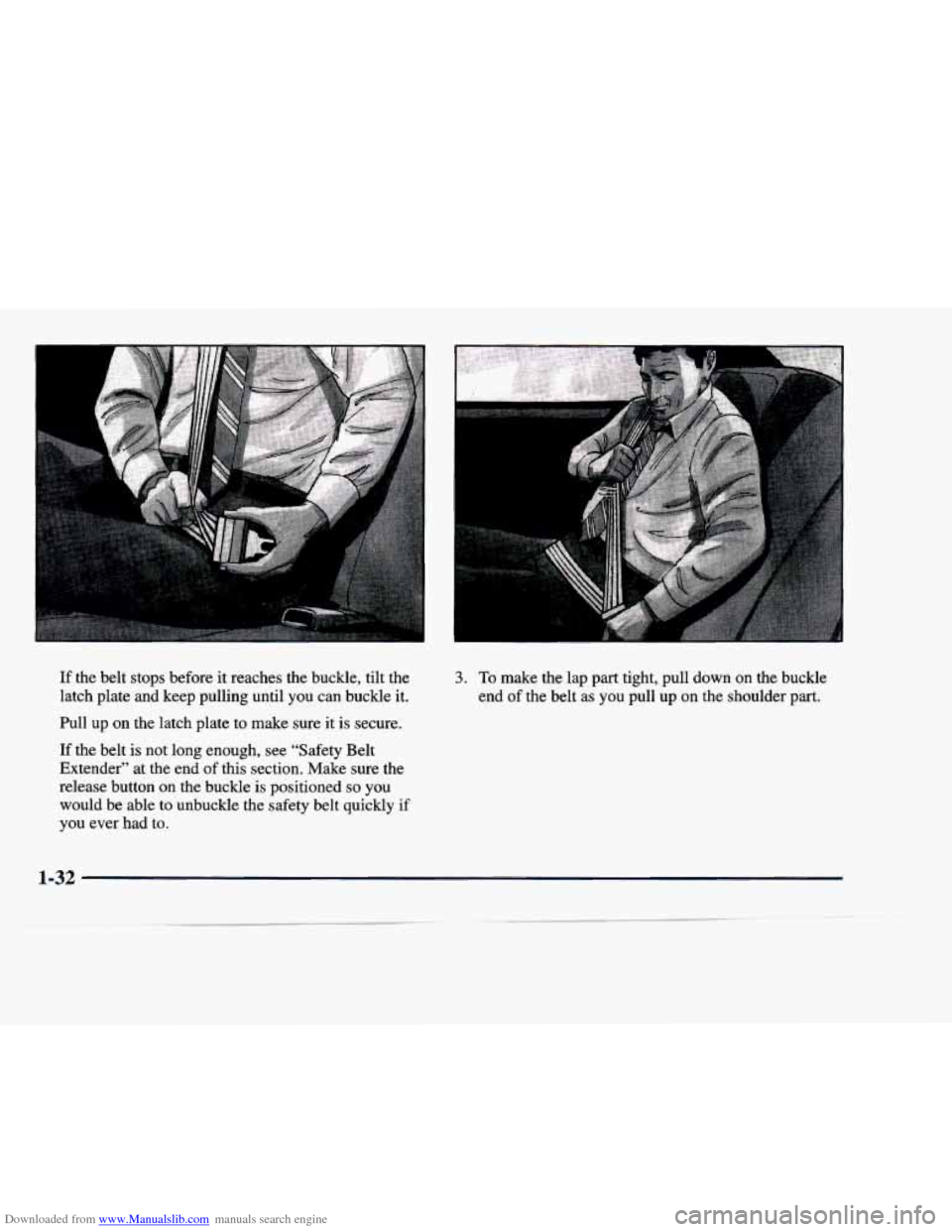
Downloaded from www.Manualslib.com manuals search engine If the belt stops before it reaches the buckle, tilt the
latch plate and keep pulling until you can buckle it.
Pull up on the latch plate to make sure it is secure.
If the belt is not long enough, see “Safety Belt
Extender” at the end of this section. Make sure the
release button on the buckle is positioned
so you
would be able to unbuckle the safety belt quickly if
you ever had to.
3. To make the lap part tight, pull down on the buckle
end
of the belt as you pull up on the shoulder part.
1-32
Page 49 of 386
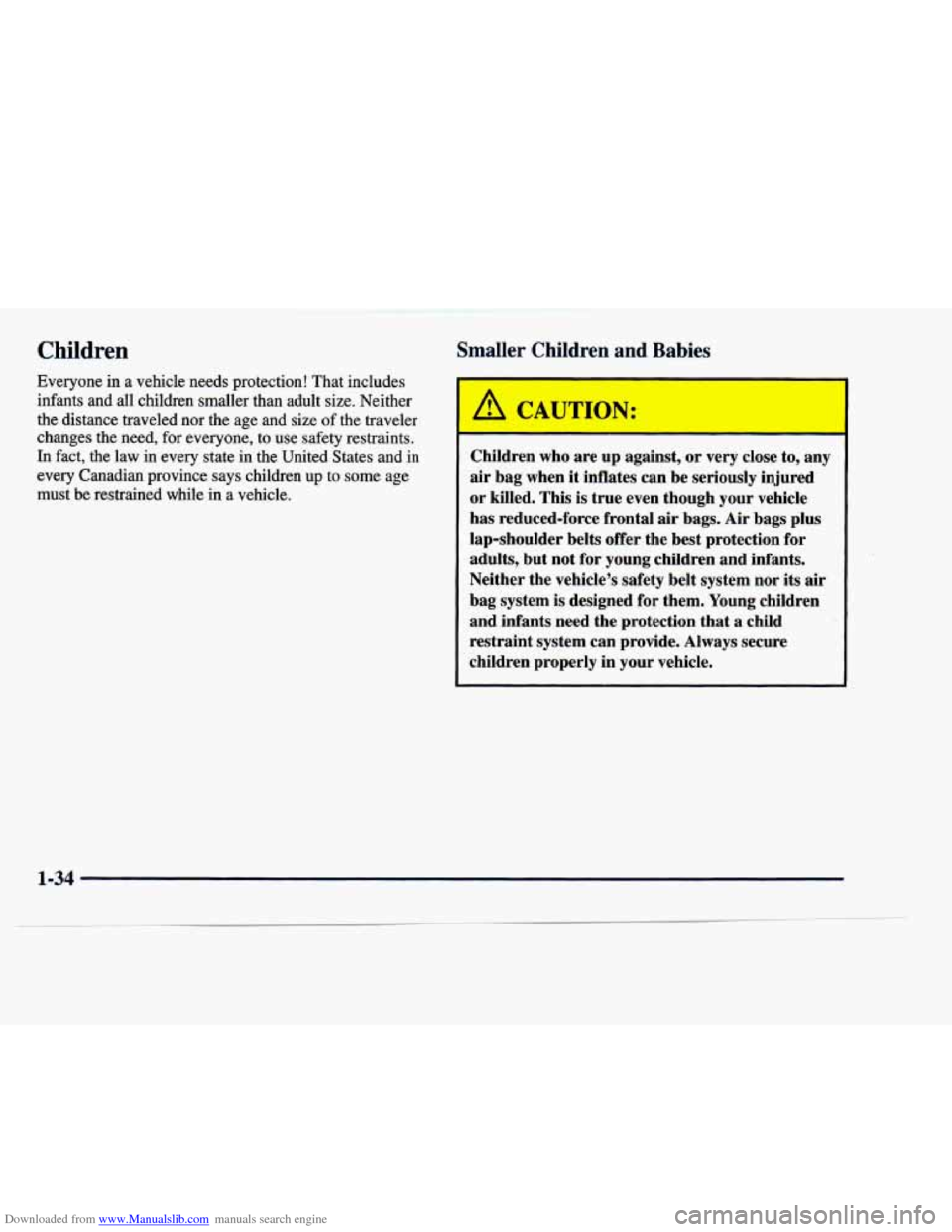
Downloaded from www.Manualslib.com manuals search engine Children Smaller Children and Babies
Everyone in a vehicle needs protection! That includes
infants and all children smaller than adult size. Neither
the distance traveled nor the age and size
of the traveler
changes the need, for everyone, to use safety restraints.
In fact, the law
in every state in the United States and in
every Canadian province says children up to some age
must be restrained while in a vehicle.
b CAUTION:
I
Children who are up against, or very close to, any
air bag when it inflates can be seriously injured
or killed. This is true even though your vehicle
has reduced-force frontal air bags. Air bags plus
lap-shoulder belts offer the best protection for
adults, but not for young children and infants.
Neither the vehicle’s safety belt system nor its
air
bag system is designed for them. Young children
and infants need the protection that a child
restraint system can provide. Always secure
children properly in your vehicle.
1-34
Page 50 of 386
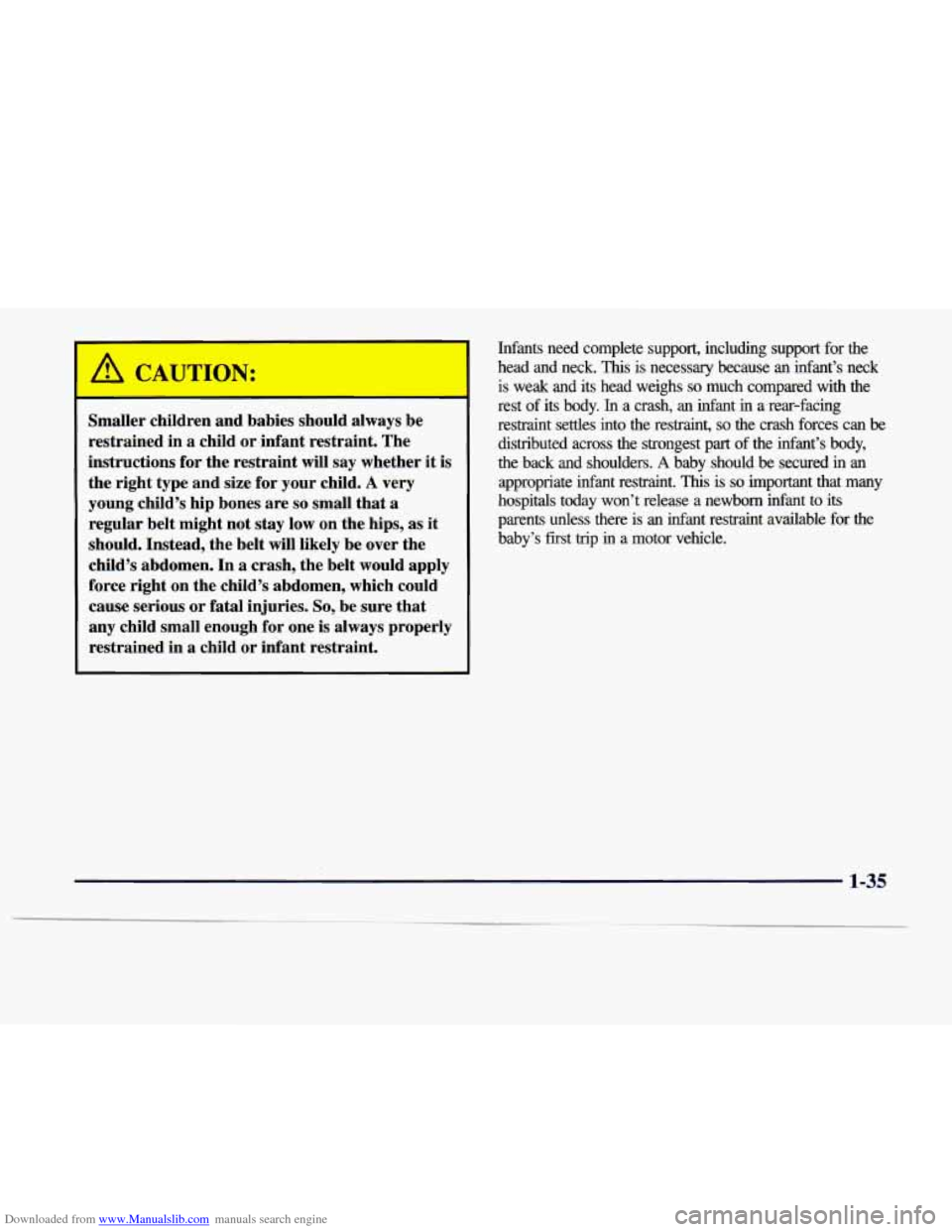
Downloaded from www.Manualslib.com manuals search engine I A AUTION:
Smaller children and babies should always be
restrained in
a child or infant restraint. The
instructions for the restraint will say whether it is
the right type and size
for your child. A very
young child’s hip bones are
so small that a
regular belt might not stay low on the hips, as it
should. Instead, the belt will likely be over the
child’s abdomen.
In a crash, the belt would apply
force right on the child’s abdomen, which could
cause serious or fatal injuries.
So, be sure that
any child small enough for one is always properly
restrained in a child or infant restraint.
Infants need complete support, including support for the
head and neck.
This is necessary because an infant’s neck
is weak and its head weighs so much compared with the
rest of its body.
In a crash, an infant in a rear-facing
restraint settles into the restraint,
so the crash forces can be
distributed across the strongest part of the infant’s body,
the back and shoulders.
A baby should be secured in an
appropriate infant restraint. This is so important that many
hospitals today won’t release a newborn infant to its
parents unless there is an infant restraint available for the
baby’s first
trip in a motor vehicle.
1-35
Page 51 of 386
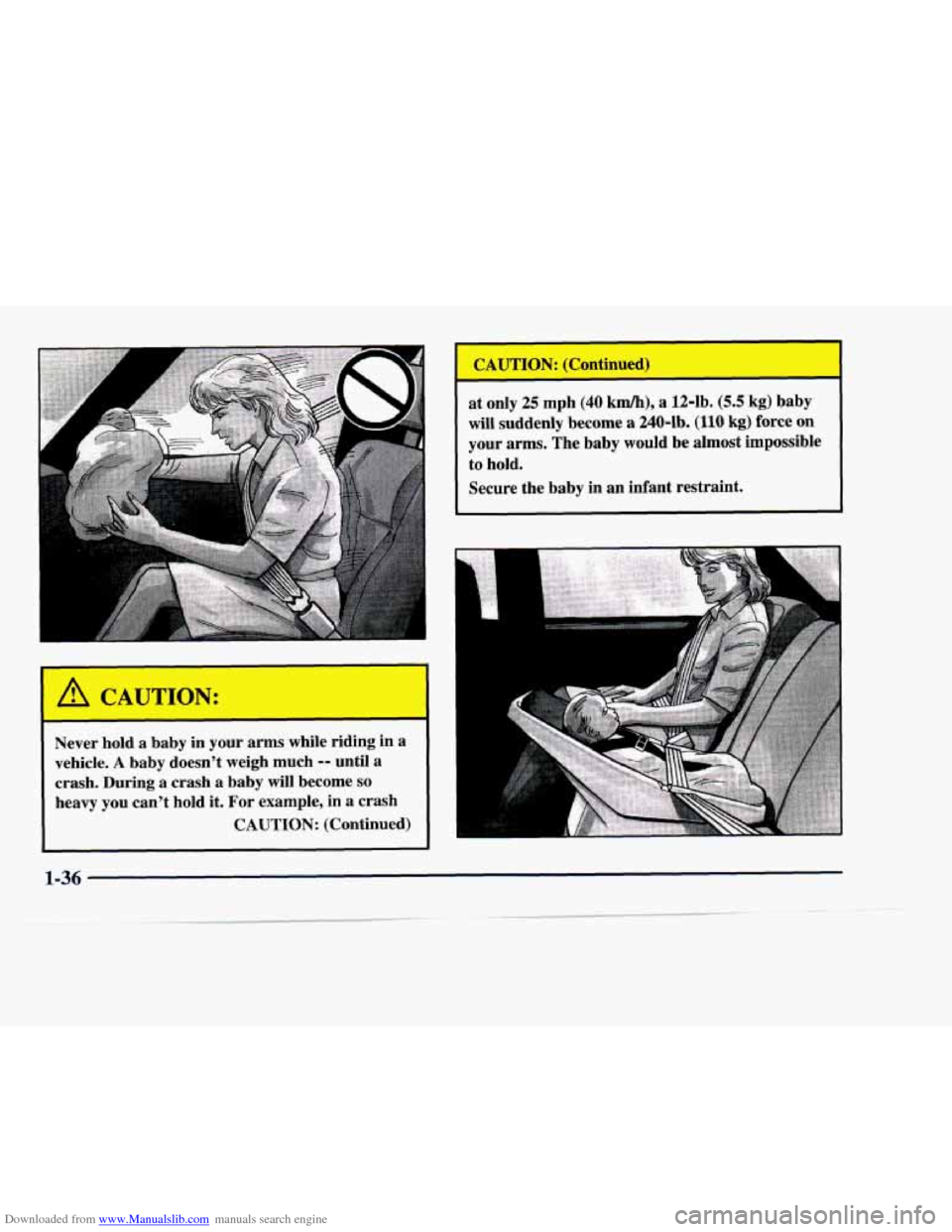
Downloaded from www.Manualslib.com manuals search engine CAUTION: (Continued) -
at only 25 mph (40 km/h), a 12-lb. (5.5 kg) baby
will suddenly become a 240-1b. (110
kg) force on
your arms. The baby would be almost impossible
to hold.
Secure the baby in an infant restraint.
Never hold a baby in your arms while riding in a
vehicle.
A baby doesn't weigh much -- until a
crash. During a crash a baby will become
so
heavy you can't hold it. For example, in a crash
CAUTION: (Continued)
1-36
Page 53 of 386
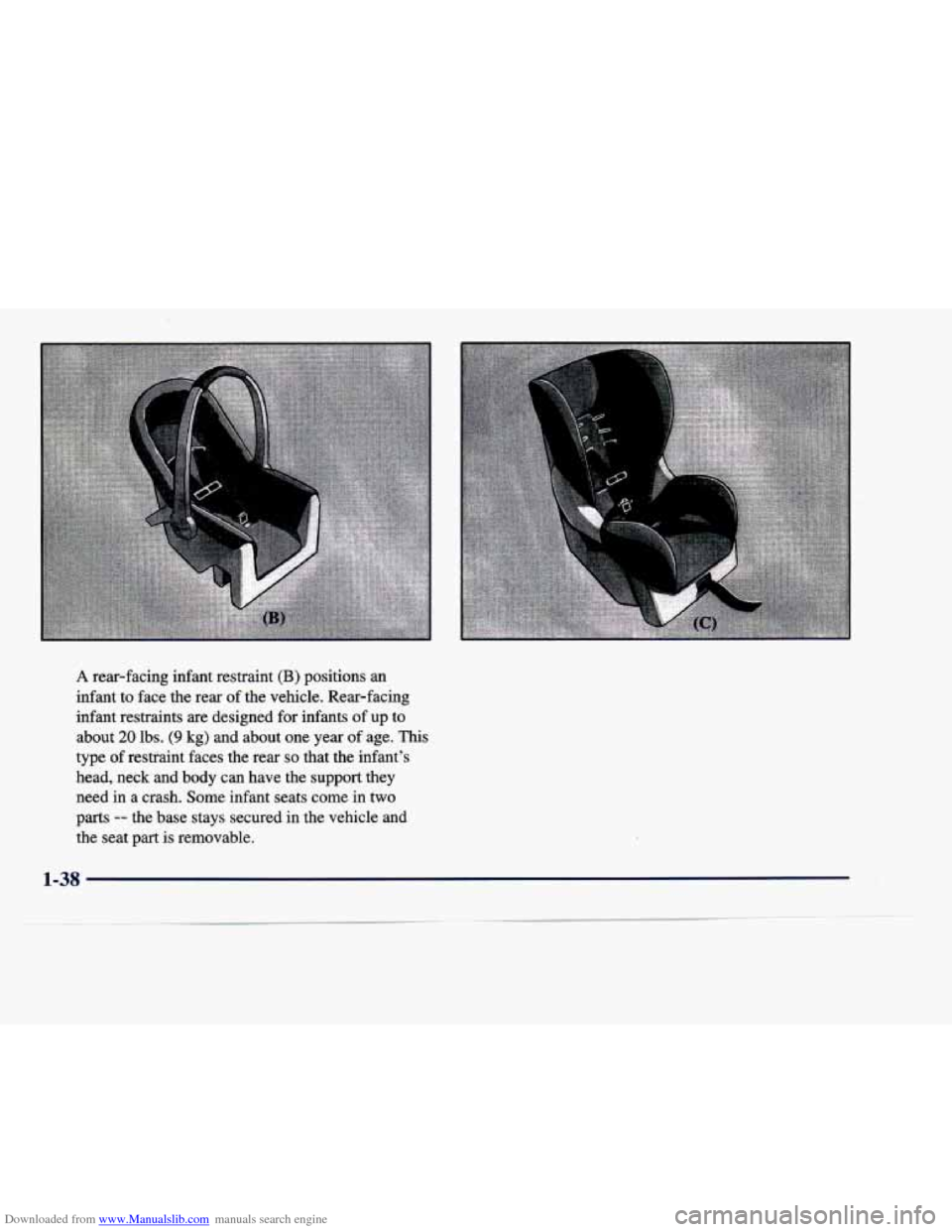
Downloaded from www.Manualslib.com manuals search engine A rear-facing infant restraint (B) positions an
infant to face the rear
of the vehicle. Rear-facing
infant restraints are designed for infants of up to
about
20 lbs. (9 kg) and about one year of age. This
type
of restraint faces the rear so that the infant’s
head, neck and body can have the support they
need in
a crash. Some infant seats come in two
parts
-- the base stays secured in the vehicle and
the seat part is removable.
Page 56 of 386
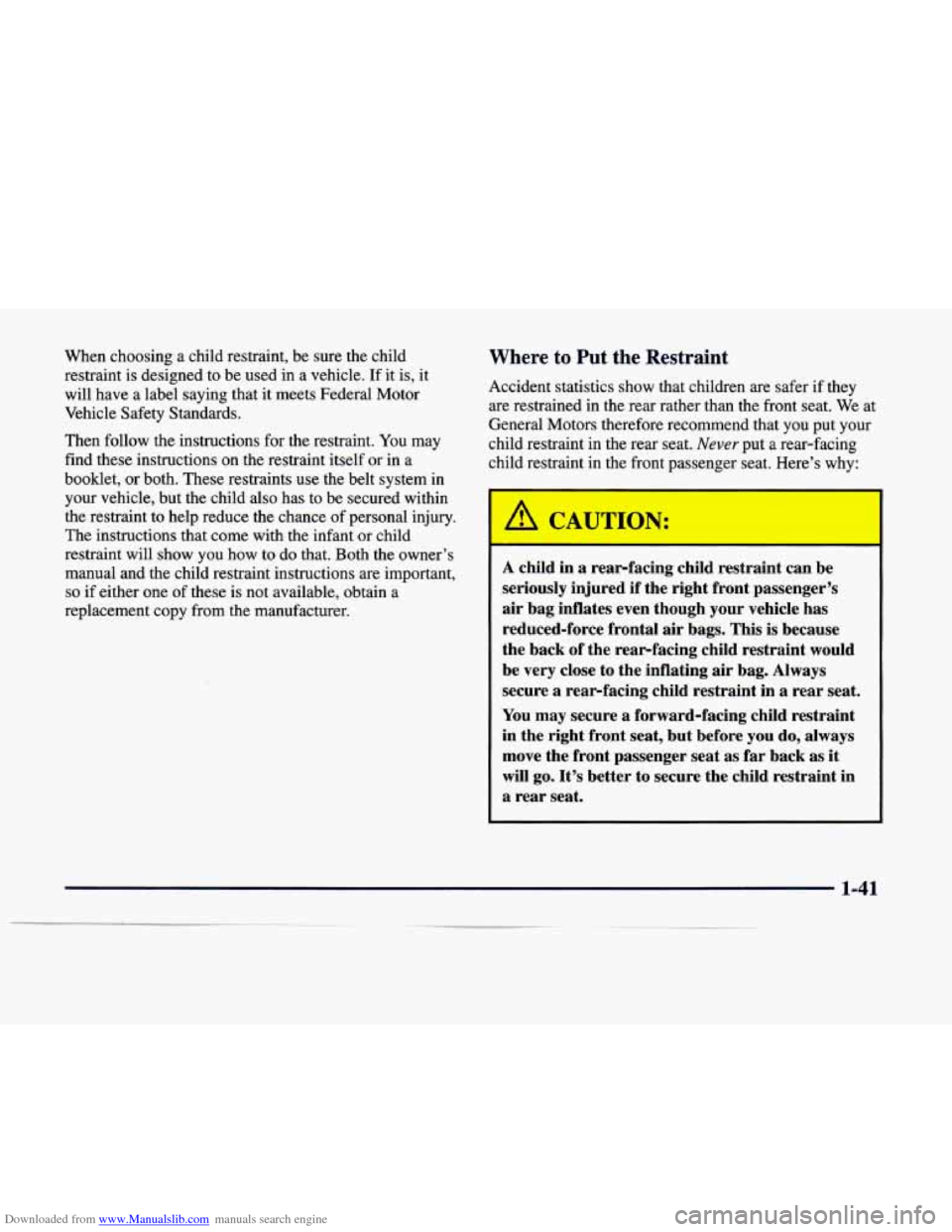
Downloaded from www.Manualslib.com manuals search engine When choosing a child restraint, be sure the child
restraint is designed to be used in a vehicle. If it is, it
will have a label saying that it meets Federal Motor
Vehicle Safety Standards.
Then follow the instructions for the restraint.
You may
find these instructions on the restraint itself or in a
booklet, or both. These restraints use the belt system
in
your vehicle, but the child also has to be secured within
the restraint to help reduce the chance
of personal injury.
The instructions that come with the infant or child
restraint will show you how to do that. Both the owner’s
manual and the child restraint instructions are important,
so if either one of these is not available, obtain a
replacement copy from the manufacturer.
Where to Put the Restraint
Accident statistics show that children are safer if they
are restrained in the rear rather than the front seat. We at
General Motors therefore recommend that you put your
child restraint in the rear seat.
Never put a rear-facing
child restraint in the front passenger seat.
Hc ’s why:
A CAUTION:
-
A child in a rearfacing child restraint can be
seriously injured if the right front passenger’s
air bag inflates even though your vehicle has
reduced-force frontal air bags. This is because
the back of the rearfacing child restraint would
be very close to the inflating air bag. Always
secure
a rearfacing child restraint in a rear seat.
You may secure a forward-facing child restraint
in the right front seat, but before you do, always
move the front passenger seat as far back as it
will go. It’s better to secure the child restraint in
a rear seat.
1-41
Page 57 of 386
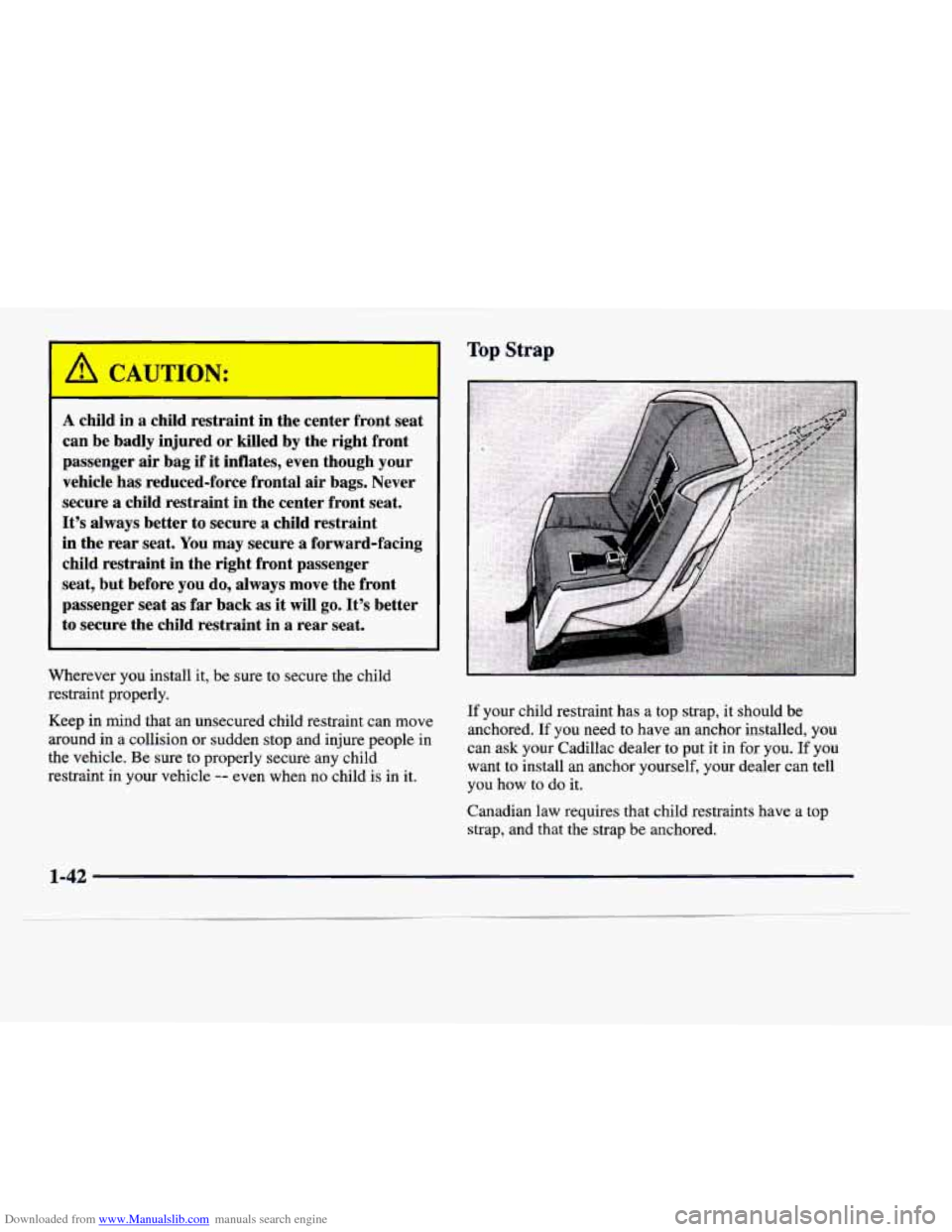
Downloaded from www.Manualslib.com manuals search engine I
A child in a child restraint in the center front seat
can be badly injured or killed by the right front
passenger air bag
if it inflates, even though your
vehicle has reduced-force frontal air bags. Never
secure a
child restraint in the center front seat.
It’s always better to secure
a child restraint
in the rear seat. You may secure
a forward-facing
child restraint in the right front passenger
seat, but before you do, always move the front
passenger seat as far back as it will go. It’s better
to secure the child restraint in a rear seat.
Wherever you install it, be sure to secure the child
restraint properly.
Keep in mind that an unsecured child restraint can move
around in a collision or sudden stop and injure people in
the vehicle. Be sure to properly secure any child
restraint in your vehicle
-- even when no child is in it.
Top Strap
If your child restraint has a top strap, it should be
anchored.
If you need to have an anchor installed, you
can ask your Cadillac dealer to put it
in for you. If you
want to install an anchor yourself, your dealer can tell
you how to do it.
Canadian law requires that child restraints have a top strap, and that the strap be anchored.
1-42